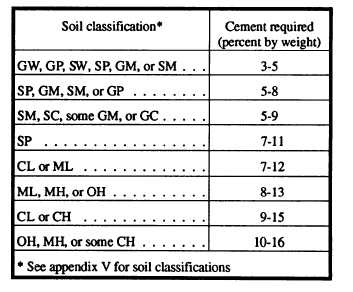gradation and absence of fines in these sands,
construction equipment may have difficulty in obtaining
traction. Traction can be vastly improved by keeping the
sand wet and by using track-type equipment. These soils
are likely to be “tender” and to require care during final
packing and finishing so that a smooth, dense surface
may be obtained.
3. Silty and clayey soils make satisfactory soil-
cement but those containing high clay contents are
harder to pulverize. Generally the more clayey the soil,
the higher the cement content required to harden it
adequately. Construction with these soils is more
dependent on weather conditions. If the soil can be
pulverized it is not too heavy textured for use in soil-
cement.
SOIL-CEMENT TESTS
Laboratory tests determine three fundamental
control factors for soil-cement. These factors are as
follows:
1. Proper cement content
2. Proper moisture content
3. Roper density
An adequate cement content is the first requisite for
quality soil-cement. Well before construction, the soils
at a project site should be identified, the limits of each
soil defined, and a representative sample of each soil
type should be forwarded to the laboratory to determine
the quantity of cement required to harden it. A soil
survey of the construction area should be made.
Proper soil surveying, identification, and sampling
are important. For instance, if one soil type was sampled
and tested while actual construction involved a different
soil type, the tests would be worthless and, in fact,
detrimental since they would mislead the engineers.
Obviously, it is important to sample and test the soils
that will actually be used in soil-cement construction. A
75-pound sample of each type of soil is adequate for
laboratory testing.
Sampling methods and procedures are discussed in
the EA3 TRAMAN and in NAVFAC MO-330. Soil
samples are usually taken from a graded roadway by
digging a trench from the center line to the edge of the
proposed pavement and to the depth of processing. Soil
samples for proposed roadways not yet graded are taken
with an auger from the various soil horizons of each soil
type from the “dressed-down” face of exposed cuts or
from the surface. Samples should be taken so that only
one horizon of each soil type is represented by each
sample. Similarly, it is not good practice to take a
composite sample from various locations. Data obtained
from a composite sample does not apply to soil in any
single location and may be misleading. There are
exceptions. For instance, in sampling pit material that is
to be loaded during construction by a shovel operating
over the vertical face of the pit, the sample is taken from
the bottom to the top of the vertical face after the
overburden is removed. On small projects, it is not
uncommon to sample only the poorest soil on the job,
and the cement content for this sample is used
throughout the job. Be sure that complete identification
is supplied with each sample.
The purpose of laboratory testing is to determine the
minimum cement content needed to harden the material
adequately and the optimum moisture content (OMC)
and density values to be used for construction. The
OMC and maximum density are determined by the
moisture-density test and the required cement content
is determined by either the wet-dry test for pavements
located in nonfrost areas or the freeze-thaw test for
pavements located in frost areas. A brief description of
each test is provided below.
. The moisture-density test determines the OMC
and maximum density for molding laboratory
specimens and, in the field, to determine the quantity of
water to be added and the density to which the
soil-cement mixture should be compacted.
Before you start this test, select the cement contents
that will be used in the wet-dry or freeze-thaw test. The
cement contents are usually selected in 2-percent
increments to encompass values given in table 18-3.
Table 18-3.—Basic Range of Cement Requirements
18-6

